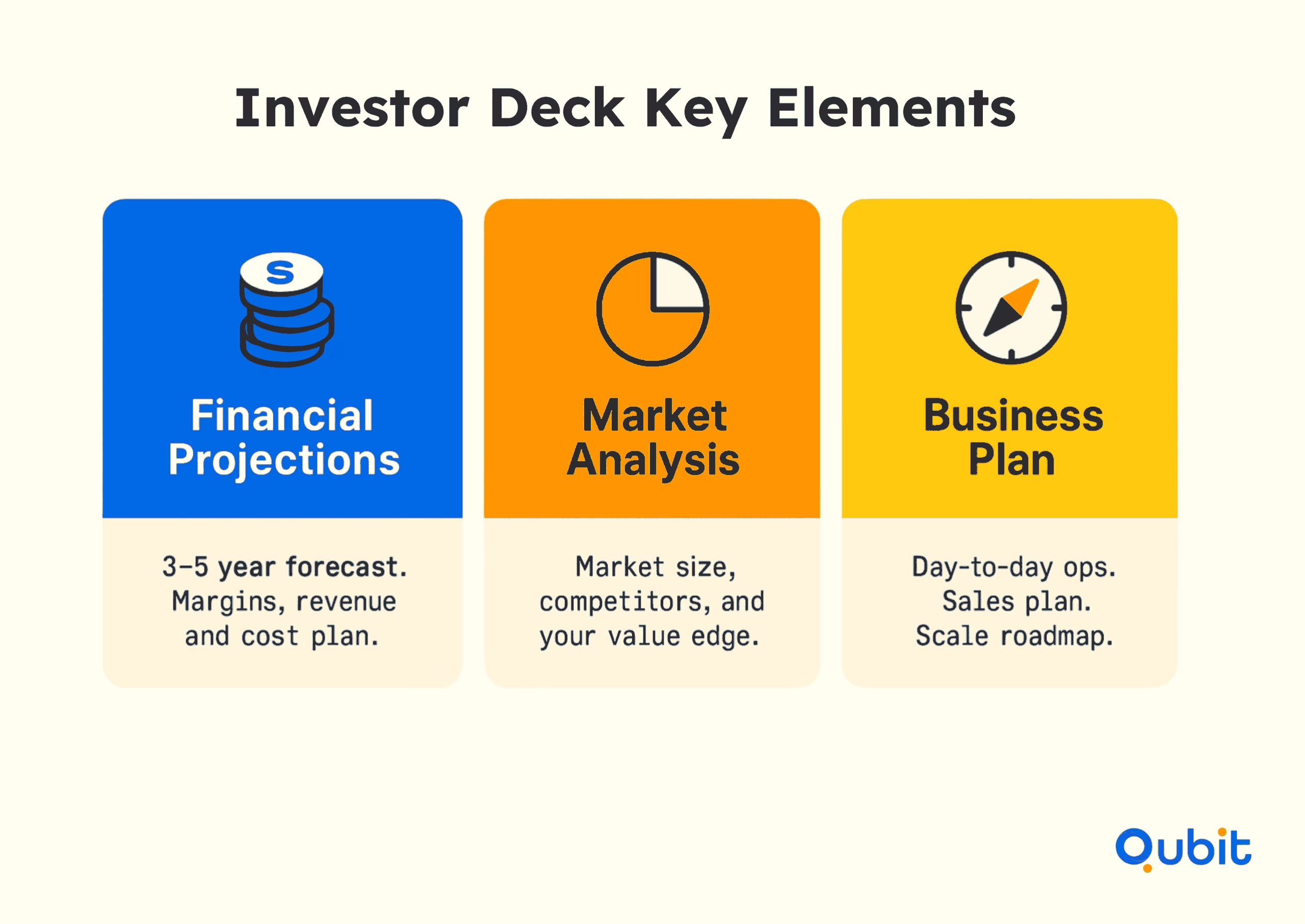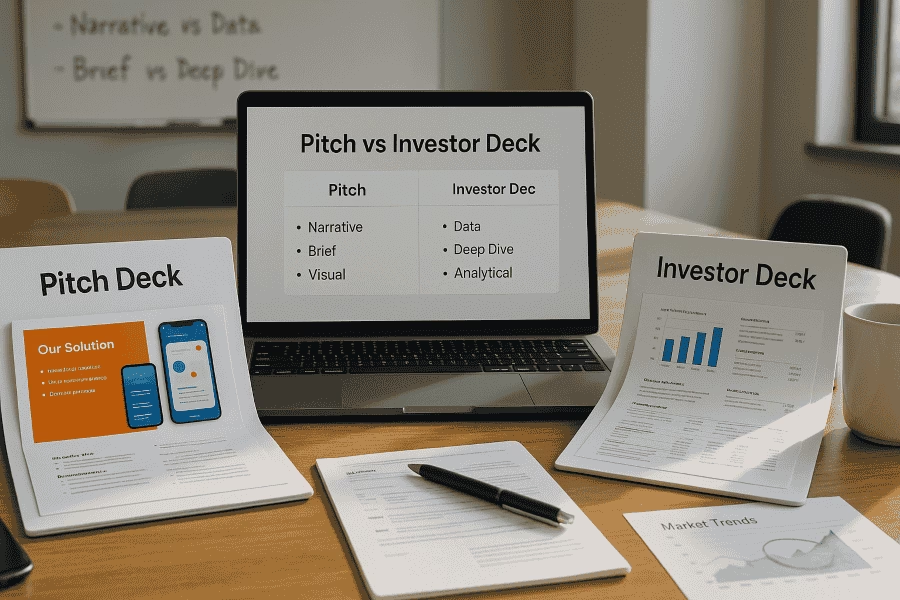When presenting your startup to potential stakeholders, understanding the nuances between a pitch deck and an investor deck is crucial. While both serve as tools to communicate your business vision, they cater to distinct audiences and purposes. A pitch deck is often designed to captivate and engage, focusing on storytelling and the broader vision of your brand deck. On the other hand, an investor deck dives deeper into financials, metrics, and growth strategies, appealing to those evaluating the viability of your business.
You can also examine how startups create business portfolio to get an understanding of how different narratives resonate with the potential audience. This blog will explore the key differences between these two essential presentation formats and provide actionable strategies for crafting each effectively.
Let’s jump right in!
Master the Strategies for an Effective Pitch Deck
Mastering the strategies for an effective pitch deck requires a blend of creativity, clarity, and audience awareness. Whether you're targeting investors, partners, or clients, a well-structured pitch deck can spark interest, secure follow-up meetings, and engage diverse audiences.
Let's walk through this creative process together:
1. Define the Purpose of Your Pitch Deck
A pitch deck serves as a snapshot of your brand, offering a concise yet impactful overview of your business idea, goals, and value proposition. Unlike an investor deck, which delves into detailed financials and operational specifics, a pitch deck emphasizes memorable sound bites and visual storytelling.
As Marc Stoiber aptly notes, “A pitch deck deals more in memorable sound bites, while an investor deck provides details that are key to decision-making.” This distinction underscores the importance of tailoring your pitch deck to its audience and purpose.
2. Harness the Power of Storytelling
Storytelling transforms data into a narrative that resonates emotionally with your audience. Begin by identifying the core message you want to convey, whether it's your brand's mission, the problem you're solving, or the unique value you bring to the market. Structure your pitch deck like a story, with a clear beginning, middle, and end. For example:
- Beginning: Introduce the problem or opportunity.
- Middle: Highlight your solution and showcase your product or service.
- End: Conclude with a call to action or a vision for the future.
3. Prioritize Visual Appeal
A visually appealing pitch deck is more likely to capture attention and leave a lasting impression. Use clean, professional design elements, such as consistent fonts, colors, and layouts, to reflect your brand identity. Incorporate visuals like charts, graphs, and images to simplify complex information and make your presentation more dynamic.
For example, use your market size slide to showcase the growth opportunity with varied visuals—clean charts, intuitive icons, and subtle brand-color accents—so investors understand the scale at a glance.
4. Tailor Content to Your Audience
Knowing your audience is crucial to creating a pitch deck that resonates. Are you speaking to potential investors, partners, or clients? Each group has unique priorities and expectations.
- Investors: Focus on growth potential, market size, and financial projections.
- Partners: Highlight collaboration opportunities and mutual benefits.
- Clients: Emphasize your product's value and how it solves their problems.
5. Keep It Concise and Impactful
A pitch deck should be concise, typically no more than 10–15 slides. Each slide should deliver a clear message without overwhelming the audience with excessive text or data. Use bullet points, short sentences, and visuals to convey information effectively.
If you're unsure how to balance brevity with depth, refer to how to create a pitch deck for a broader context on crafting impactful presentations.
Dive Deep into Crafting a Winning Investor Deck
Creating an investor deck that resonates with potential backers requires more than just a polished presentation—it demands a strategic approach rooted in data-driven insights. A well-crafted brand pitch can be the difference between securing funding and being overlooked. This section explores the essential components of a winning investor deck, focusing on financial projections, market analysis, and a comprehensive business plan tailored to convince funding-oriented investors.
The Core Elements of a Winning Investor Deck
Investor decks are not just about showcasing your business idea; they are about presenting a compelling case for why your venture is worth the investment. To achieve this, your deck must address three critical areas:

1. Financial Projections: Demonstrating Viability
Investors want to see numbers that tell a story of growth and profitability. Your financial projections should include:
- Revenue forecasts: Break down expected income streams over the next three to five years.
- Expense analysis: Highlight operational costs, marketing budgets, and other expenditures.
- Profit margins: Showcase how your business plans to achieve sustainable profitability.
Ensure these figures are realistic and backed by solid assumptions. Investors are quick to spot overly optimistic projections, so balance ambition with credibility.
2. Market Analysis: Proving Opportunity
A comprehensive market analysis demonstrates that your business operates within a lucrative and scalable industry. Include:
- Market size and growth potential: Use data to quantify the opportunity.
- Target audience: Define your ideal customer and their needs.
- Competitive landscape: Identify key competitors and explain your unique advantage.
A look into competitive positioning is complemented by the insights in pitch deck competition slide, where the discussion of visualizing market competition offers a practical perspective.
3. Business Plan: Mapping the Path to Success
Your business plan is the blueprint for achieving your goals. It should outline:
- Operational strategy: Detail how your business will function day-to-day.
- Marketing and sales strategy: Explain how you will attract and retain customers.
- Scalability: Highlight how your business can grow over time.
A clear and actionable plan reassures investors that you have thought through every aspect of your venture.
Addressing Challenges Thoughtfully
Every business faces challenges, and investors appreciate transparency. Use your deck to acknowledge potential obstacles and present strategies for overcoming them in the pitch deck problem slide . This would help you bring a deeper understanding to present challenges thoughtfully within your investor deck.
Tailoring Your Deck for Maximum Impact
While the core elements remain consistent, the presentation style should be tailored to your audience. For instance, some investors may prefer a data-heavy approach, while others might respond better to storytelling. Understanding your audience allows you to craft a deck that speaks directly to their priorities.
For those wondering how investor decks differ from other investment documents, the nuances between various presentation formats emerge clearly when you consider the detailed comparison provided in pitch deck vs PitchBook, which illustrates how similar tools can serve distinct purposes.
Conclusion
Whether you're crafting a pitch deck to captivate a broad audience or an investor deck to secure funding, understanding the nuances of each format is key. While pitch decks focus on storytelling and high-level engagement, investor decks demand detailed financial insights and strategic clarity.
By aligning your content with the expectations of your audience, you can create impactful presentations that resonate and drive results. If you're ready to take actionable steps, consider seeking expert guidance to ensure your deck stands out.
At Qubit Capital, we specialize in creating compelling pitch decks that leave a lasting impression. Explore our Pitch Deck Creation Service today and let us help you bring your vision to life.
Key Takeaways
- Pitch decks and investor decks serve different roles in the funding journey.
- Pitch decks use concise visuals to spark initial interest.
- Investor decks include detailed financials, market analysis and strategy.
- Internal links boost navigation and link to deeper resources.
- Tailor your content and level of detail to each audience.
Frequently asked Questions
Is it a pitch deck or investor deck?
A pitch deck is crafted to grab attention through concise storytelling, while an investor deck dives deeper into financials and market analysis to persuade investors.


 Back
Back



